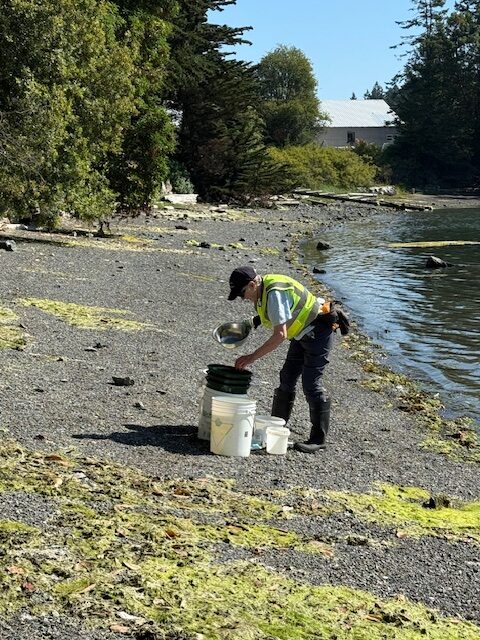The most recent (or only?) research into surf smelt (Hypomesus pretiosus) is a 2002 paper from the Department of Fisheries and Oceans Canada.
Some of you may recall the Harper government's destruction of scientific research, and firing of many scientists in government. There was a commercial fishery for surf smelt in Roberts Bay, peaking more than 100 years ago, and some are still being caught as pet food.
Surf smelt (and all other small forage fishes—Pacific sand lance, herring, anchovies, eulachon, and sardines) feed about a hundred different species of birds and wildlife, like seals, whales, orcas, salmon, mink, otters, etc. Surf smelt come up at high tide and lay their eggs in the sand, and the eggs stay there for about 12 days in summer or 20 in winter, before hatching.
I was asked what the ideal surf smelt spawning beach would look like. My personal thought is, it would be below a forested area, leading to a sand/pea gravel beach, with a few logs along the shoreline and a creek or stream with a spring water source running into it. I have not figured out what the ideal aspect would be...north, south, east, or west facing. It depends on the geology of the land, ocean currents, and prevailing winds. Beaches are dynamic—constantly shifting and changing. The beach surface and substrate is amazingly different from one beach to the next around here, and they change quite dramatically with the seasons and storms.
In Tsehum Harbour, two of the most productive surf smelt beaches on Vancouver Island have several other beaches in sight, across the water or around the harbour. One has very little pavement behind it...only cement steps leading down to it, with a variety of mature trees at one end. No roads, sidewalks, parking lots, or other paved areas behind. The other has mature trees, and an eroding bank between the beach and a parking area. Lots of creosote treated wood and invasive species were removed in an adjacent area about 3 or 4 years ago, and spawning has improved quite considerably since then. Spawning is much more abundant at these two beaches than any of the others in the area.
To improve beach areas for spawning and remove non-native species and plant native trees and plants, see info@bcinvasives.ca.
When we survey, we note location including acknowledging the Indigenous land the sample site is on, air and water temperatures, any unusual recent weather events, wildlife sightings, backshore composition and how impacted it is, date and time of day, last high tides and height, wind direction and speed, how much shade is on the beach, and the dominant size of sand/gravel on the beach. We take GPS coordinates of sites, so we can return to the same locations again to check.
There are significant changes happening. The heat dome in 2021, recent land use changes, a lot of shoreline development (sewer and water line replacements, housing construction and renovations), and house fires all seem to add to the deterioration of our beaches. In recent years, the water has been warming, which is not helpful for healthy eggs.
Beaches are nourished by material washed from leaf litter, needles, and eroding land. Marine life needs the minerals that fulvic acid (from leaf litter) washes into the ocean. Dr. Diana Beresford-Kroeger gives us lots of information in her books. Most recent is Our Green Heart: The Soul and Science of Forests (ISBN # 978-1-03--900979-0, available as an eBook and locally at Tanner's Books in Sidney).
So, to make your beaches or shoreline more conducive to spawning, plant native plants and trees. Encourage your municipality to plant lots of native trees, and to keep mature trees (instead of allowing developers to clear lots before building). If you have trees on your property, take care of them, and water them during dry summer months. You may have noticed the unfortunate killing effects of drought on cedars, madrones (arbutus), and even now the Douglas firs.
For more information on surf smelt and beaches: www.peninsulastreams.ca/our-work/beach-program/. If you want to volunteer to survey for forage fish egg spawning, beach cleanups, or restoration work, you can sign up on the website.
They also list groups that will come and assess your property to improve your shoreline. The Stewardship Centre for British Columbia has a Green Shores program that can help landowners improve their property.
Sandra Foss
BEACH Program Volunteer
"I am grateful to serve from the traditional territory of the WSÁNEĆ peoples represented by the W̱JOȽEȽP (Tsartlip), BOḰEĆEN (Pauquachin), SȾÁUTW̱ (Tsawout), and W̱SIḴEM (Tseycum) Nations."
Photo credit to John Ingham.
*An edited version of this blurb was published in the Roberts Bay Residents newsletter.


Good info here for looking after beaches.